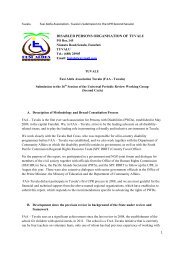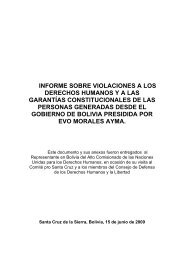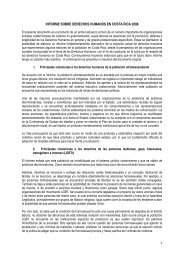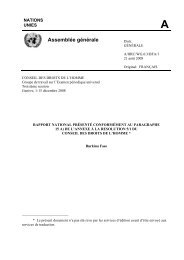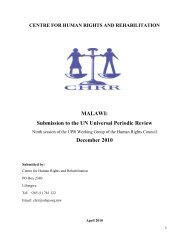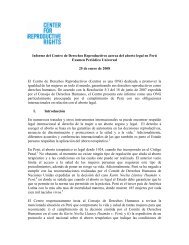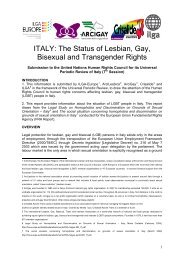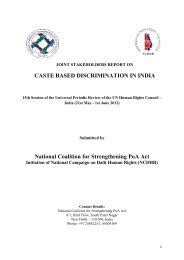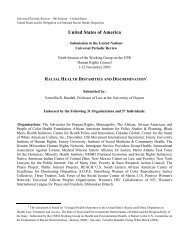Prison Needle Exchange: Lessons from a Comprehensive Review ...
Prison Needle Exchange: Lessons from a Comprehensive Review ...
Prison Needle Exchange: Lessons from a Comprehensive Review ...
Create successful ePaper yourself
Turn your PDF publications into a flip-book with our unique Google optimized e-Paper software.
Canadian developments<br />
Further evidence of injection-related<br />
risk behaviours during incarceration<br />
In the past three years, researchers with the Vancouver Injection Drug Users Study (VIDUS)<br />
have published a number of peer-reviewed articles that further illustrate the relationship<br />
among injection drug use, imprisonment and HIV status. 12 Since its inception in 1996, the<br />
VIDUS study has enrolled over 1500 people who inject drugs, over 1000 of whom report<br />
that they have been incarcerated at least once since they first began injecting drugs. Of those<br />
who had spent time in prison, 351 people reported that they had injected drugs while incarcerated.<br />
13 A 2003 article reported that VIDUS study participants who had recently been<br />
incarcerated were 2.7 times more likely to become HIV-positive than those who had not been<br />
to jail or prison. 14 An external evaluation of the attributable risks reported in that study concluded<br />
that 21 percent of the HIV infections among injection drug users in Vancouver were<br />
likely acquired in prison. 15 The VIDUS researchers subsequently analyzed syringe sharing<br />
in prison. 16 They found that incarceration in the six months prior to being interviewed was<br />
associated with syringe lending by HIV-positive VIDUS study participants during that period.<br />
Similarly, among HIV-negative participants, incarceration in the six months prior to<br />
being interviewed was associated with syringe borrowing during that period.<br />
VIDUS researchers have also published qualitative evidence regarding injection drug use<br />
by VIDUS study participants during periods of incarceration. 17 The small-scale study of<br />
recently released prisoners confirmed the previous reports that injecting within the prison<br />
environment is characterized by a pattern of syringe sharing among large networks composed<br />
of numerous individuals. The study also found that due to the scarcity of syringes,<br />
and out of fear of not being able to obtain syringes <strong>from</strong> other prisoners, HIV-positive prisoners<br />
conceal their status <strong>from</strong> injection partners. Study participants also indicated that<br />
bleach distribution is an incomplete solution. Given the illegality of drug use and the possibility<br />
of being caught by prison officials, drug injection is often hurried and prisoners generally<br />
do not decontaminate needles with bleach because this would take too long to complete.<br />
The authors conclude:<br />
Considering the increasing prevalence of blood-borne viruses, the high levels of<br />
syringe sharing documented and the fact that prison-based syringe exchange programs<br />
have demonstrated positive impact in other contexts, the potential of a program<br />
to provide sterile syringe access for Canadian inmates merits exploration. 18<br />
Another peer-reviewed article, published in 2005, reports on a study of female prisoners in<br />
a British Columbia institution in which both provincial and federal prisoners were incarcerated.<br />
19 Of the 104 prisoners who participated in the study, 74 percent reported that their current<br />
prison sentence was related to drug use, 94 percent reported illegal drug use prior to<br />
incarceration, and 65 percent reported injection drug use prior to incarceration. Twenty-one<br />
percent (22/104) of prisoners reported injection drug use inside prison; of this number, 91<br />
percent (20/22) reported being HCV seropositive. Two prisoners reported being both HCV<br />
and HIV seropositive. Nineteen of twenty-two prisoners who reported injecting while in<br />
prison reported sharing a syringe with other prisoners, and three reported not cleaning used<br />
syringes with bleach. Self-reported HIV and HCV infection rates among the prisoners were<br />
8 percent and 25 percent, respectively. The authors conclude:<br />
In British Columbia, as in the rest of Canada, imprisoned injection drug users are<br />
not able to access sterile injection equipment, which undermines harm reduction<br />
iv <strong>Prison</strong> <strong>Needle</strong> <strong>Exchange</strong>: <strong>Lessons</strong> <strong>from</strong> a <strong>Comprehensive</strong> <strong>Review</strong> of International Evidence and Experience



